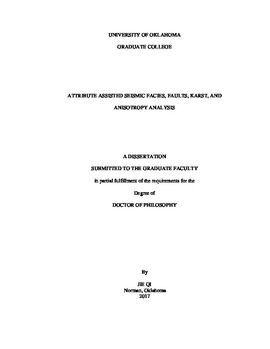| dc.description.abstract | Seismic attributes provide quantitative measures of key statistical, geometric, or kinematic components of the 3D seismic volume. These measures can thus be subsequently used in 3D visualization, interactive crossplotting, or computer-assisted facies analysis. In this dissertation, I evaluate the attribute expression of seismic facies including karst collapse features, mass transport complexes, turbidites, and salt using 3D visualization and 3D pattern recognition.
One of the more common and more important seismic facies is salt. Salt segmentation is critical for accelerating velocity modeling, which in turn is necessary for seismic depth migration. In general, geophysicists need to pick the high velocity salt interface manually. In the first chapter of the dissertation, I present a semi-supervised multiattribute clustering method, and apply it not only to salt segmentation, but also to mass transport complex, shale, and sand segmentation in the Gulf of Mexico. I develop a 3D Kuwahara filtering algorithm, and smooth the interior attribute response and sharpen the attribute contrast between one face with neighboring facies. Then, I manually paint target facies to evaluate the ability of candidate attributes to discriminate each seismic facies from the other. Crosscorrelating their histogram, candidate attributes with low correlation coefficients provide good facies discrimination. Kuwahara filtering significantly increases this discrimination. Kuwahara filtered attributes corresponding to interpreter-defined facies are then projected against a Generative Topological Mapping (GTM) manifold, resulting in a suite of n probability density functions (PDFs). The Bhattacharyya distance between the PDF of each unlabeled voxel to each facies PDF results in a probability volume of each interpreter-defined facies.
In the second chapter, I introduce a 3D fault enhancement and skeletonization workflow. For large datasets, interpreter hand-picking of faults can be very time-consuming. This process can be accelerated by generating high resolution edge detecting attributes. Coherence is an algorithm that measures both stratigraphic and structural discontinuities. Application of a directional Laplacian of a Gaussian (LoG) filter to coherence volumes provides more continuous and sharper faults. To further increase fault resolution and preserve stratigraphic discontinuities, I skeletonize the filtered coherence volumes perpendicular to the discontinuities with the goal of providing subvoxel resolution. “Fault” points doesn’t fall on the geometric grid suggesting the distribution of the value onto eight neighboring grid points. I demonstrate this fault enhancement and skeletonization workflow through application to two datasets from New Zealand and the Gulf of Mexico.
With the advent of shale resource plays, wide azimuth acquisition has become quite common. Migrating seismic gathers into different azimuthal bins provides a means to estimate horizontal stress and natural fractures. Different azimuths preferentially illustrate faults perpendicular to them. However, coherence applied to the lower fold azimuthally limited seismic volumes is contaminated by noise. In the third chapter, I improve the energy ratio coherence algorithm and extend it to map more subtle discontinuities, which can only be seen in different azimuthally limited seismic volumes. The main modification compared to the original energy ratio coherence algorithm is that I add the weighted covariance matrices of each azimuthal sectors together to form a single covariance matrix, thereby improving the signal-to-noise ratio. I apply this multi-azimuth coherence algorithm to two datasets from the Fort Worth Basin.
In the fourth chapter, I summarize attribute-assisted interpretation in the Barnett Shale and the Ellenburger Group. Karst, faults, and joints are known to form geologic hazards for most Barnett Shale wells in the Fort Worth Basin. In the best cases, these drilling-related geohazards form conductive features that draw off expensive hydraulic fracturing fluid from the targeted shale formation. In the worst cases, the completed wells are hydraulically connected to the underlying Ellenburger aquifer and produce large amounts of water that must be disposed. Karst collapse generates a distinct morphologic pattern on 3D seismic data. I show that multiple attributes delineate different components of the same geologic features, thereby confirming my interpretation. | en_US |
